
ONTARIO

London
NO PART OF THE FOLLOWING
ARTICLE AND PHOTOGRAPHS
MAY BE REPRODUCED WITHOUT
PERMISSION FROM THE AUTHOR ©
Springbank's genesis dates back to 1877. That year, $400,000 was pledged to build a water plant next to a large hill at the site of Coombe's mill on the western south bank of Thames River in nearby Byron Village. (One source gives a value of $325,035.24) The property was purchased and a dam built on the adjacent river so that water power would work the pumps. These pumps filled a reservoir on the hill by drawing water from collecting ponds which were fed from local springs. (Hence the name "Springbank".) From there, gravity supplied the force to push water to homes and businesses in nearby London.
|
The Water Works Circa 1909  |
The city made the region presentable by putting the plant in a cottage-like building and landscaping the surrounding area. They also continued to buy land nearby until they would come to own over 150 hectares by 1911 (218 from another source). The water works and infrastructure were completed in 1878, with a steam back-up plant added in 1881. The pumphouse still occupies the site today, but it was modified sometime in the 1900s with an addition to the building's south side. One of the original holding ponds also exists. It is near Storybook Gardens.
The area around the plant, which became known as "Chestnut Park", was such a nice spot that residents began to travel there to picnic despite the fact that the road to it was impassable for most of the year. Early on (1879 is implied by one source), a look-out was built on Reservoir Hill as it had become known, because it was so high up. It consisted of a simple gazebo-type of open-sided structure.
Seizing on the need for transport, The Thames Navigation Company established regular ferry trips there in September of 1878. By the following season a refreshment concession was initiated in a building next to the pumphouse. As well, a second ferry company, London and Waterworks Line, started service that year. Rivalry escalated between the two companies with Thames Navigation adding a second ferry, placing a band on the first, and offering moonlight cruises. At some point, a hotel was constructed next to the pumphouse with a dock for the ferries. it's possible the building that housed the refreshment stand was this hotel.
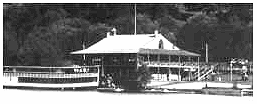
|
The Thames ferry docks along side of the park's hotel. |
Just as the park got going, its popularity diminished as a result of some mishaps - one very serious. The indirect cause was the ferry company rivalries, which in earlier seasons resulted in several near misses and one collision. On May 24th, 1880 The L & WL Victoria and The T.N.C. Forest City were close to one another in the river. When passengers reached out from each boat to touch hands, the Forest City captain thought his ship was being grappled. He forced The Victoria near the shore where the vessel grounded and sustained damage to the upper-deck covering from a large overhanging branch. After freeing itself, Victoria met the returning Forest City and through a mixup of signals the two collided. Fortunately this resulted in no injuries. However, the following year to the day, people would not be so lucky.
On May 24th, 1881, a large crowd was in Chestnut Park for the Victoria Day holiday and most stayed until well into the afternoon. Consequently, when Victoria arrived, 600 (800 from another estimate) boarded her. This was a major overage and the captain knew it. The ship was only 21 by 8 meters at its most, with only two passenger decks. Although he and some of the crew were able to prevent others from boarding, they were unable to get enough tired picnickers to wait for the next ferry. That meant the ship would be much lower in the water than its usual half-meter draught.
As Victoria began its return journey around 5 PM, that lowness in the water allowed it to scrape bottom or some obstruction below the surface near Cove Bridge. The ship started to take on water and to list. Many passengers then moved to the high side of the ship causing it to unbalance, where upon it turned over to that side, water ran over onto the deck and the ferry began to sink. The ship listed so badly, the boiler let go its moorings and crashed through the upper deck supports. This weakened the deck and with the overcrowding, it gave way, crushing those below. The ship capsized and at least 181 were drowned, crushed by the upper deck, or crushed/scalded to death by the loosened boiler.
Few persons in the local London area escaped losing a family member or friend. Estimates at the time placed the death toll as high as 215, but 181 seems to be the number most quoted, now, that figure being taken from the internment list. It shows persons ranging in age from 1 to 72 years of age, with most being in their teens through thirties. A hearing was held but no judgement was ever passed against the ship owners. One of the youngest survivors lived until 1976.
Subsequent years saw ferry service decline after the accident, then pick up as the incident faded into the past, then decline yet again, but due to competition from improved roads and rail service to the area. A disastrous flood in 1883 did not help either. 1898 would be the final year for steamer service.
Because of the Victoria accident, much business was lost in favour of Port Stanley Park, only about 40 or 50 kilometers away by road. However, Chestnut Park continued on and by the 1890s had begun to become popular again. Starting in 1892 the city cleaned up the area, made & gravelled paths, and placed benches & swings in the area. They adopted the name "Springbank" for the park which formally opened in 1894.
A private developer also added a dance hall next to the park in an area called "Wonderland". London Street Railway saw potential for business and requested permission to run its trolley lines right into Springbank. Service began on Nay 25th, 1896, spelling the end for ferry service. Because power was run in for the streetcars, the park was able to be electrically lit, which was a novelty for the time. It created a new and interesting night time atmosphere. By 1897, summer stock theater was being performed at the park.
The next season saw the park's main pavilion burn and a larger one built for 1898 to take its place. It included two towers. Along with the new structure, an open-air theater was constructed presumably for the theater troop. At some point, a wading pool was located near this structure. Some loss of business was experienced in 1900 due to the waterworks dam being partially destroyed because of high spring run-off. This laid up many pleasure boats for the season. The dam was repaired and business resumed the following season.
|
The park's new 1898 pavilion. Note the
tower at Center & Top Right and the
peak of the second one to the left
above the roof.
|
A New Pavilion
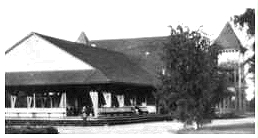
|
Street lighting was in the park by the turn of the century. The photo below shows the Upper Road curving away from the camera, as seen from the North Street entrance road. White globes sit atop ornamented iron posts along the road's edge.
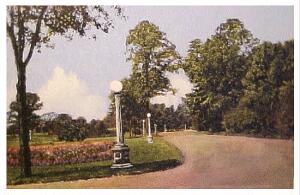
|
Park Path 1910s |
In the first decade of the 20th century, the gardens were enhanced with the hiring of a permanent caretaker. As well, tennis courts and bowling lawns were opened, and the roads were improved.
|
Pavilion Lawns Circa 1909 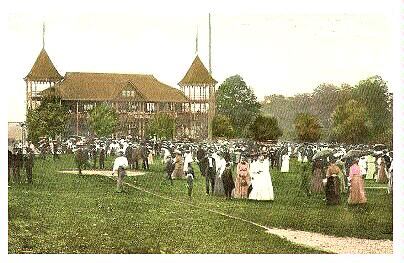
|
| Park goers enjoy a sunny day near the pavilion. This view shows the opposite side of the building from the previous photo. The sandy areas appear to be horseshoe pitches. |
A draw to the area, if not for recreational reasons, was that a Tuberculosis Sanatorium was built on the hill overlooking the area and many persons that came to visit invalid friends & relatives would take some time to partake in the nearby diversions.
With the increased business, a full-fledged amusement park was a logical next step. Run by the Victor Amusement Company, the park opened in 1914 (1915 is given by another source) both on the city property and on private land across Springbank Drive at the park's southern border. A zoo and campground were established (which would become an automobile campground by 1922). Over the next five years a carousel (Herschell ?) and roller coaster were added along with a "Razzle Dazzle" (Herschell), paddle boats, mini cars, bowling alleys, ferris wheel, bumper cars, the "House of Mirth" (1919), and a penny arcade. George Cotton, a local farmer, opened a shooting gallery and a fish pond. Across the river, a golf facility was opened in 1924, The Thames valley Golf Course.
A second carousel is mentioned in one reference. Recent evidence suggests that it may have used the horses from the first one to make a larger 3-row unit. After Springbank amusement park closed in the 1940s, its carousel may have gone to Burlington Beach.
Rose Jankowiak formerly at the Herschell Museum says: "Several of our volunteers rode the carousel at Burlington Beach and clearly remember it because of its unusual mixture of horses. The two inner rows of the museum carousel are older horses that were converted from rockers to jumpers. They formerly rode on a two-row steam-operated carousel. We are not sure just how old they are, but they are early Herschell-Spillman style: stiff legged, smiling, simple carvings, stand-up manes along the neck, and they have real horse hair tails."
"They were brought to Allan Herschell when the owner wanted a bigger carousel but didn't want to pay for inner row horses when he already had 24 of them. Hence, their conversion. Their presence on the carousel makes it a very unique machine."
The problem is that both Springbank and Burlington parks had early carousels, so either might have been modified to make this new one. However, both parks could not have had the same ride at the same time during the 1910s and afterwards. The evidence seems to suggest that Springbank had modified its carousel and that it went to Burlington in the 1940s. That ride eventually ended up at the Herschell museum where it may be seen today.
Another possibility is that Springbank bought its first carousel used from Burlington Beach and then only two years later, incorporated that one's horses into the modified one being discussed here. Later, the modified ride went to Burlington. Research continues. See the Burlington Beach article for photos and the carousel story from its point of view.
The roller coaster at the park was The "Cannon-Ball". Sometimes known as The "Cannonball Express", it was built no later than 1918 just south of the main park across Commissioners Street, apparently by Jack Reddington of Scranton, Pennsylvania. No date as to when it was removed has come up, but it lasted at least until 1942 when Victor Amusement went out of business. It was owned and operated by Fran Wells at some point during its history.
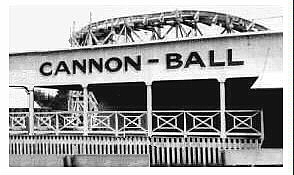
|
Entrance to the
Cannon-Ball Coaster 1920s or 1930s |
There may also have been a "Figure 8" roller coaster dating from 1915. Dan MacKellar and I have seen pictures of The "Cannon-Ball" and we agree it's not a "Figure 8" design. I have to assume that either there was a second coaster in the park or that one source thought The "Cannon-Ball" was a "Figure 8" design built in 1915.
Ice cream was delivered to the park by the McNiece family until 1920. One of the drivers was often Rhea Crowe. Another food concession in the park was Charlie Haddad's popcorn wagon. It was there during at least the late 1930s.
In 1920, a miniature steam railway was put in. This was a stream- lined train built by Louie Haddad, Bob McKewn, & Bill Shearme, and it supposedly only operated for one year. It apparently eventually ended up at Port Stanley Amusement Park in 1942. Where it was from 1921 to 1941, is not yet known. A second train then opened at Springbank. Another source gives 1923 as the year a train opened at Springbank. However, since the streamlined train was supposedly in the park for just one year, I suspect the 1923 date is the year the second train came to the park.
To add more confusion, Alan Sutherland is the grandson of Ernest George Yeates, the consulting engineer who further developed Springbank as the water supply for London in the early 1900s. He says Ernest was the miniature railway builder for Dundurn Park which had opened in 1888. That ride came to Springbank park at some point. Perhaps it was a second train and opened in 1922. Then, the 1923 train was yet a third one.
This last train was 381mm gauge and was built in Scotland. It ran at Springbank until 1965 when it was bought by the Supertest gasoline company as a gift to the local Lion's Club whom wanted to continue running it as a fund raiser. However, it was difficult to find someone to run & maintain a steam locomotive, so the engine was converted to diesel (gasoline, says another source) that year.
|
Springbank Park Miniature Train circa 1962 or 63  |
In this J.M. Milner photo, an engineer inspects the park's miniature locomotive just before a run. Note the passenger car inside the station at Center Left. |
The converted train ran as The "Springbank Flyer" until 1998 when it was transferred to a location close to Storybook Gardens (see below). A new train known as The "Springbank Express" was placed on a new 350-meter track layout and a new station was built. This was all donated by Sifton Properties as part of its 75th Anniversary celebrations. It was reported that in 1999, plans were being made to connect the old and new track layouts so that people could use the train for transportation to the wading pool at the old location. There is no word on whether this has been done.
Getting back to the early amusement park, sometime in the early 1920s, a dance hall was constructed. For the 1927 season it was redone inside and lighting effects installed. The hall remained popular right to the end of World War II. Unfortunately, it burned in 1946. Another dance hall, built in 1935, was called "Wonderland Gardens". I assume it was in the Wonderland area of the park and likely replaced the 1890s hall. Wonderland Gardens consisted of a swimming pool and an open-air dance floor. An additional floor which was enclosed, was added later on. The Gardens building still exists today.
References list rides and attractions from the 1920s onward to include a carousel, ferris wheel, roller coaster, an aerial swing (1927), "Seaplanes" ride, (This was likely a refurbishment of the Traver "Aerial Swing", meaning the two would not have been there at the same time), a dance pavilion, "House of Mystery", "Dodgem" bumper cars (possibly from Erie Beach Park which closed at the end of the 1930 season), a penny arcade, and several games & food outlets. In addition were the boxball and bowling alleys, and one source lists a pool hall. There is a funhouse listed which was likely the "House of Mirth". Although listed separately from the "House of Mystery", it may have been the same attraction with a new name and new features. Victor Amusement apparently also provided uniformed officers to guard vehicles and direct traffic in the parking lot at least in the 1920s.
Another source lists a suspension footbridge that may have been built around 1928. It crossed the Thames River between the eastern end of the park and a golf course. This golf course may be a more recent addition, as it does not show up in any other past references. The bridge was scheduled to be replaced in 2000.
The park began to decline not long after the start of World War II. Apparently The Victor Amusement Company ceased operations in 1942, as the rides were put up for sale. However, one or more attractions may have remained because they were run by other concessionaires who presumably still made money - the miniature railroad, as detailed before, being one of them. The carousel may have gone to Burlington Beach. The main park north of Springbank Drive continued to operate with some concessions.
In 1958 a children's attraction called "Storybook Gardens" opened. There is some confusion about this, in that a previous section of the park may have used the name as early as 1914. This appears to have been the zoo. I suspect that the zoo was simply renamed and reworked in 1958 as "Storybook Gardens", using a Mother Goose theme.
Regardless, as a kick-off, two seals were brought in from California as an addition to the zoo. However, one escaped into The Thames River and eventually made it's way to Lake Erie where Toledo Zoo officials captured it near Sandusky, Ohio (home of famous Cedar Point amusement park). They claimed it as theirs due to the fact that it was collared in American waters and because the Canadian zoo officials had given up the search. There was such an outrage in London that Canadian zoo officers went to Toledo where the zoo was persuaded to give up the sea lion along with a baby puma named "Lucky" as a goodwill gift. When "Slippery", as he was dubbed, returned home, there was a major parade and thousands poured into Storybook Gardens. It was later discovered that part of this was a publicity stunt and that there was never any likelihood that Toledo Zoo was not about to return the seal to its rightful owners. Storybook Gardens may still be found at Springbank today with a petting zoo (containing deer, donkey, elk, goats, and peacocks), picnic grounds, and the "Storybook Queen" - a 90 minute boat tour on the Thames River.
Despite this resurgence, Springbank continued to decline and in the 1960s it reverted to a public park once more, likely after Byron Village's annexation to London in 1961. It is linked to other nature parks in the area via a system of trails and bicycle paths. Today, Springbank Park, as Storybook Gardens, has the miniature train and a 1965 Herschell three-row Carousel. It was bought at auction by London for $21,000 and was slated to have been moved closer to Storybook Gardens in 2003 during renovations. Part of the old amusement site south of Springbank Drive is now a housing development that began to be developed in the 1940s after that park closed.
(* The amusement park's 1942 closing date is in question as it's not known if some or all of the rides continued to operate for a season or more while they were up for sale.)
|
Thanks to Harold Deeks of London, Ontario for sharing his
research and facts on Springbank's trains, and for photo
information & releases. Thanks to Dan MacKellar of Lucan, Ontario for additional information on Springbank. The Hotel, Pavilion, and "Cannon-Ball" station photos are courtesy of The Byron Memorial Library Archives in Ontario. The miniature steam train photo is by J.M. Milner of London, Ontario and was sent courtesy of Harold Deeks. For more on Springbank Park and Storybook Gardens, see: -Springbank Park History -Storybook Gardens -Storybook Gardens Picture Site |
Return to the
Closed Canadian Parks Index
